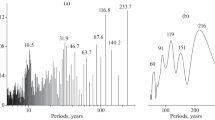Abstract
The Elatina formation in South Australia, which provides a rich fossil record of presumptive solar activity in the late Precambrian, is of great potential significance for the physics of the Sun because it contains laminae grouped in cycles of about 12, an appearance suggestive of the solar cycle. The actual spectrum of the lamina-thickness series is rather complex, 20 or more spectral lines having been recognized by Fourier analysis. It is shown how these numerous lines arise as combination frequencies, from a much simpler intrinsic spectrum, by rectification. Optical studies of the Sun have shown that there is a magnetic polarity reversal on the Sun every 11 years approximately, but terrestrial consequences of solar activity, for example in the ozonosphere or ionosphere, do not respond to solar magnetism; thus the negative-going semi-cycles of the full magnetic cycle are in effect rectified according to a linear law. Application of this knowledge to the Elatina formation shows that derectification simplifies the spectrum of the laminathickness series in exactly the way that one would expect if the solar cycle were at work here also. Zig-zag effect, an alternation of cycle thickness, is taken to be due, not to a beat phenomenon, but to rectification in the presence of a weak 345-year oscillation; subtraction of this oscillation after derectification is essential to the simplifying procedure. The fundamental period is established at a new sharper value of 23.7 ± 0.2 years as compared with the looser 22.2 ± 1.8 years for the modern sunspot series. This paper treats the laminae as varves laid down yearly and modulated in thickness in accordance with the late Precambrian sunspot activity for the year of deposition. Since the difference between 23.7 and 22.2 is less than a standard deviation it is premature to speculate that the sunspot cycle period has undergone secular change; indeed the possibility that the solar oscillator has been secularly stable is not ruled out. The high Q now demonstrated for the varve oscillator (around 120 compared with a previous value of 12) weakens support for that part of solar dynamo theory that ascribes the solar cycle to a self-sustaining relaxation osculation; conversely, the evidence for an internal solar clock mechanism is strenghtened. A wave propagation zone intervening between the clock and the solar surface could produce the intrinsic spectrum.
Similar content being viewed by others
References
Bracewell, R. N.: 1953, Nature 171, 649.
Bracewell, R. N.: 1985, Australian J. Phys. 38, 1009.
Bracewell, R. N.: 1986a, The Fourier Transform and Its Applications (encond ed. revised), McGraw-Hill, New York.
Bracewell, R. N.: 1986c, Nature 323, 516.
Bracewell, R. N.: 1986b, The Hartley Transform, Oxford University Press, New York.
Bracewell, R. N.: 1986c, Nature 323, 516.
Bracewell, R. N.: 1988a, Solar Phys. (in press).
Bracewell, R. N.: 1988b, Monthly Notices Roy. Astron. Soc. (in press).
Bracewell, R. N.: 1988c, Quart. J. Roy. Astron. Soc. (in press).
Bracewell, R. N. and Williams, G. E.: 1986, Monthly Notices Roy. Astron. Soc. 223, 457.
Bailey, M. E., Clube, S. V. M., and Napier, W. M: 1986, Vistas Astron. 29, 53.
Cole, T. W.: 1973, Solar Phys. 30, 103.
Cole, G. H. A.: 1987, private communication.
Dicke, R. H.: 1978, Nature 276, 676.
Donahue, T. M., Gombosi, T. I., and Sandel, B. R.: 1987, Nature 330, 548.
Gilman, P. A.: 1981, ‘Global Circulation and the Solar Dynamo,” The Sun as a Star, NASA SP-450, p. 231.
Iyetomi, H. and Ichimaru, S.: 1986, Phys. Rev. A34, 3203.
Layzer, D., Rosner, P. and Doyle, H. T.: 1979, Astrophys. J. 229, 1126.
New Scientist, 22 October, 1987, p. 34.
Noyes, R. W., Weiss, N. O., and Vaughan, A. H.: 1984, Astrophys. J. 287, 769.
Piddington, J. H.: 1975, Astrophys. Space Sci. 38, 157.
Piddington, J. H.: 1978, Astrophys. Space Sci. 55, 401.
Prentice, A. J. R.: 1983, Proc. Astron. Soc. Australia 5, 183.
Prentice, A. J. R.: 1986, Proc. Astron. Soc. Australia 6, 394.
Soderblom, D. R. and Baliunas, S. L.: 1988, in F. R. Stephenson and J. A. Eddy (eds.), ‘The sun among the stars’, Secular Solar and Geomagnetic Variations in the Last 10000 Years, D. Reidel Publ. Co., Dordrecht, Holland.
Sonett, C. P.: 1982, Geophys. Res. Letters 9, 1313.
Sonett, C. P. and Williams, G. E.: 1987, Solar Phys. 110, 397.
Williams, G. E.: 1981, Nature 291, 624.
Williams, G. E.: 1983, in B. M. McCormac (ed.), ‘Precambrian Varves and Sunspot Cycles’, Weather and Climate Responses to Solar Variations, Colorado Assoc. Universities Press, Boulder, p. 517.
Williams, G. E.: 1985, Australian J. Phys. 28, 1027.
Williams, G. E.: 1986, Sci. Am. 255, No. 2, 88.
Williams, G. E.: 1987, New Scientist, 25 June 1987, p. 63.
Williams, G. E. and Sonett, C. P.: 1985, Nature 318, 523.
Williams, G. E. and Tonkin, D. G.: 1985, Australian J. Earth Phys. 32, 287.
Zahnle, K. J. and Walker, J. C. G.: 1987, Climatic Change 10, 269.
Author information
Authors and Affiliations
Rights and permissions
About this article
Cite this article
Bracewell, R.N. Spectral analysis of the Elatina series. Sol Phys 116, 179–194 (1988). https://doi.org/10.1007/BF00171722
Received:
Issue Date:
DOI: https://doi.org/10.1007/BF00171722




